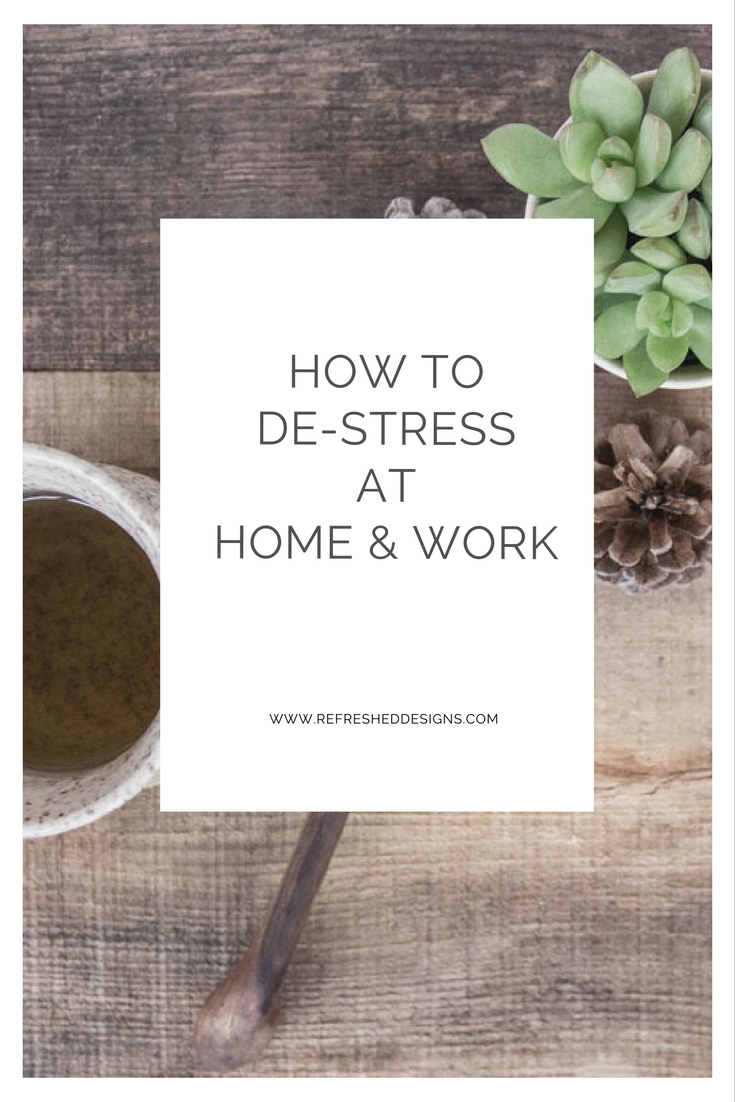Do you feel like you live in the land of chronic stress? A place that moves too fast, asks too much of you, and gives you only polluted air to breathe?
We’ve all been there from time to time. The trick is to not visit too long, because the consequences can be harmful.
Since most of us can’t take a vacation every month or go to the spa every week, we need to adopt simple everyday behaviours to de-stress in order to prevent and reverse health problems. And even better, to thrive and enjoy life. Changing our behaviour can be difficult, but giving our homes and workspaces a strategic refresh will allow us to be successful in creating new and better habits.
1. Before all else, declutter and deep clean.
A stressed space is one full of clutter, dirt and noise, and lacking comfort. And our spaces are a mirror of ourselves. So the first thing to do when you want to de-stress yourself is de-stress your home and office spaces, where you spend 90% of your time.
Clear out all clutter by finding proper homes for everything you need to keep (ie. that which is either truly useful or beautiful to you), and donate or toss the rest. Be brutal here – don’t keep old papers and files and clothing that takes up space but doesn’t add to your life. Clear lots of space on your floors, counters, chairs, benches and desktops. Then clean everything from top to bottom – using natural cleaners of course so that you don’t add chemicals to the air that will further stress your system.
2. Ground yourself in your space.
Without going too woohoo on you, Feng Shui philosophy states that we live life through our senses, and if we are too caught up in mental activities such as working on our computers, texting, attending meetings, watching screens, and worrying, we need to ground ourselves again so that we can be present in our sensory world. Our homes and offices can work to ground us with a few simple hacks.
First, eliminate all electricity running into your space that is not necessary. That means plug all computers, TVs and phones into a power bar and turn it off when not in use. Check that all large appliances in your home are properly connected, and unplug any small appliances that you rarely use. Don’t have electronics in your bedroom. Period.
Second, introduce plants to both your home and office spaces to absorb excess electrical energy, freshen the air, and connect you with nature. And introduce other earth elements like rocks, shells or wood and keep them where you can touch them – maybe in a bowl on your desk or as a table centrepiece. Seeing and touching these natural decorations will help ground you.
3. Add essential oils.
Using essential oils like lavender and sandalwood will instantly make you feel relaxed and grounded. Try making your own reed diffuser or room mist, or burn natural soy or beeswax candles in these scents. I’ve put together a guide to make it easy for you to DIY these for your home and office – just click below.
4. Create comfort zones.
Make it easy to relax and rewind at home. Set up a comfy chair for reading, doing crossword puzzles or watching your favourite Netflix show, and have a luxurious blanket and functional task light nearby. Make sure you have a side table or stool next to your chair so it’s convenient to place a hot drink. And speaking of drinks, set up a little coffee and tea station (or whatever your comfort drink of choice may be) in your kitchen so that it’s crazy-simple to brew a cup quickly when you need it . If you like taking baths, stack lots of fluffy towels near the tub and keep a jar of Epsom salts filled on the counter. Invest in quality bedding and pillows for your bedroom, and make sure the colours in your bedroom are calming; good choices include creamy off-whites or neutral earth and sea tones.
And don’t confine comfort just to your home – your workspace should be comfortable as well. Add pretty things that are both functional and beautiful to your desk space. Hang one beautiful piece of calming art (ideas here). Invest in an ergonomic chair and keep a throw and/or pillow on it so you can stay warm and cozy. Bring in your favourite slippers or chunky knit socks and keep them in a little basket on the floor. And make sure the lighting is good – if you have bad overhead lighting, bring in your own lamp and use it instead. For more ideas on creating a healthy and comfortable office,
5. Organize health zones.
Set up your home and office to reinforce good health habits. For example, keep your fridge stocked with healthy snacks, and a jar on your desk filled with your favourite granola bars. Buy a really to keep with you at all times. Keep your weights and workout shoes in a basket where you’ll see them every day and can’t ignore. Have a playlist ready on your phone for 15-minute walking breaks at work. Hang a yoga mat on your wall with hooks so you can easily take it down for a few minutes of stretching. And if you want to get really creative, figure out a way to make a standing desk – I used my IKEA dresser and it works really well – .
6. Encourage silence.
Constant noise can create stress, so we need to set up our homes, and even our offices, for some quiet time. At home, add curtains so you can pull them to mute noise from outside at night. Designate a space to sit in peace, without music or TV or computers or family members. Have something in this space that reminds you of your “happy place” so you can close your eyes and visualize being there. Meditate on this or just on your breathing for 10 minutes a day, then work up to longer periods. Write out a mantra or inspirational quote and have this where you can see it in your quiet space.
At the office, drown out noise from your officemates by wearing noise-blocking headphones. Start a silent hour once/day in your area and encourage everyone to keep to themselves and save questions and chit chat until after the 60 minutes has passed. Turn off phone and email ringers and sound notifications, at least during this hour if not for good.
7. Overhaul your nightstand and your bedtime routine.
Your bedroom is your sanctuary where you need to rest and relax. In addition to a comfy bed, your nightstand also plays a role in promoting serenity. Clear it of anything that would cause stress, such as smart phones, computers, work stuff, receipts, money, or just plain old junk. Keep it simple with a bowl or tray for a lip balm, hand cream and a place to put your watch or earrings. Add a vase of fresh flowers or a green plant. Try to get a stand with a drawer or a shelf underneath to hold one or two books for reading at night plus a journal and pencil. Get in the habit of going to bed at least 30 minutes before you need to sleep, and spend half of it writing and half of it reading. Use your journal to write down your feelings, your high-level long-term dreams and goals, or simply what you’re grateful for each day.
Achieving calm and overcoming chronic stress is easier when you set up your environments intentionally to work for you and your health. A little time up front for a quick refresh at home and the office will make a world of difference.
If you need further coaching to help you refresh your spaces so you can live a calm, comfortable and fulfilling life, I’d love to work with you.
































